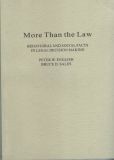用户登陆搜 索 |
查看图书
图书目录: Acknowledgments
Chapter 1. Introduction I. Behavioral and Social Facts Are Used in Legal Decision Making Chapter 2. Factual Knowledge Is Critical in Legal Decision Making Example: Mandatory Testing for Drug Use by Student Athletes Chapter 3. Multiple Sources of Factual Knowledge Example: Abortion II Why Behavioral and Social Factual Knowledge Is Used Chapter 4. Identifying and Evaluating the Factual Assumptions Underlying Law Example: Suggestibility of Child Witnesses Chapter 5. Providing the Law With Factual Knowledge to Help Set Legal Goals Example: Workplace Accommodation for Persons With Disabilities Chapter 6. Aiding in the Resolution of Factual Disputes Example: Trademark Infringement Chapter 7. Aiding in the Resolution of Factual Disputes Relating to the Constitutionality of a Law Example: Denying Female Applicants Entry into State-Supported All- Male Schools Chapter 8. Providing Factual, Educational Knowledge to Aid Legal Decision Making Example: Eyewitness Identification III. Problems Related to the Use of Behavioral and Social Factual Knowledge Chapter 9. Law Refuses to Rely on Relevant Factual Knowledge Example: Comprehension of Jury Instructions Chapter 10. Relevant Factual Knowledge Does Not Yet Exist Example: Deterring Illegal Police Behavior Chapter 11. Factual Knowledge Presented Is Irrelevant to the Legal Issue Example: Discriminatory Impact of the Death Penalty Chapter 12. Factual Research Has Limitations Example: Jury Selection Index About the Authors |

